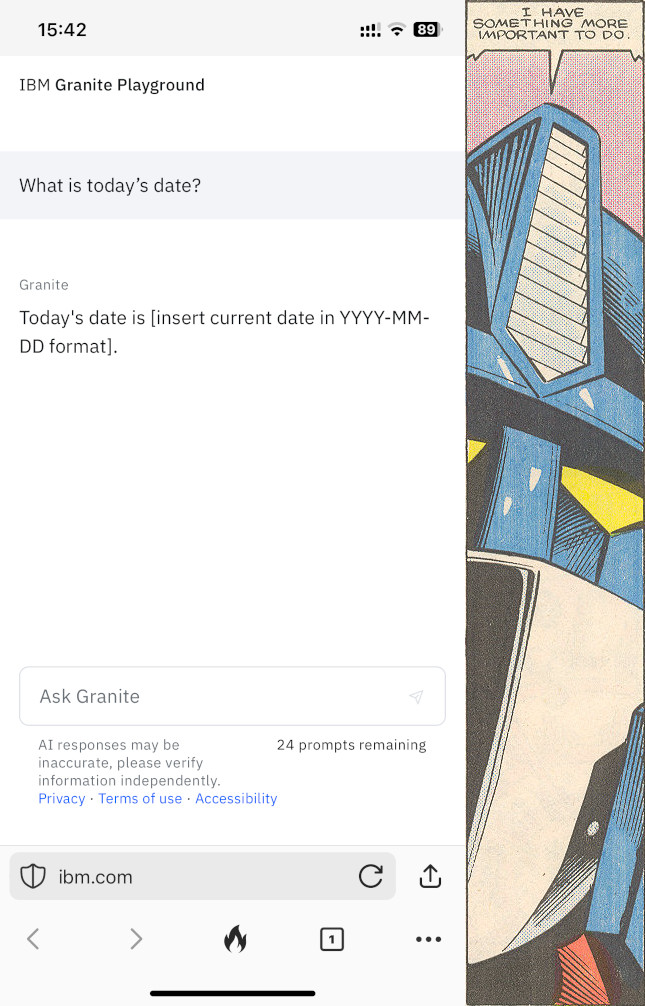

Ironically SeaMonkey, the continuation of Mozilla Suite, seems lighter than Firefox.


Ironically SeaMonkey, the continuation of Mozilla Suite, seems lighter than Firefox.
I’d have answered the same. Burning so much energy to know what date it is deserves a snarky response.



See this: https://github.com/chenxiaolong/avbroot/issues/299
The issue with the Pixel seems to be a a build-up of static in the LCD.


It’ll be easier than running uncracked games. It’s difficult to say how well your games will run in general.
That’s how we ended up with the old universe. It started out with dinosaurs and dungeons and we ended up with menial office jobs.


Random? I must be the only one left who believes in a deterministic universe ruled by cause and effect… and lizard people - big big lizard people on Mars.


At least what they ended up doing was not some crypto ponzi scheme.
Written from Librewolf, because I’ve had enough.


I just want to archive content, but if one would want such a thing I think the format to go for is WARC. As far as I understand it record the network requests, but I’m not sure as I’ve got no experience with the format at all. That way it would be possible to keep the original javascript intact and with a little manipulation of network requests to replay the original site.


It saves the rendered page. It also has a built-in rough DOM editor so that you can edit the document before saving. The way I have it set up it up is to remove all javascript from pages.


I archive with the WebScrapBook extension to htz which is also a zip based format. I open it with firefox’s built in method to open jar files like this: jar:file://${file}!/index.html
The fact that it is a zip based format makes it futureproof. I could as well unzip it and open it with any browser. You could probably open the maff files the same way, but I don’t think it is standardized to have an index.html file like htz.
AFAIK WARC is the only standard way of archiving webpages.


My guess would also be that most enterprises prefer Ada over Rust, because Rust lack standardisation. Sometimes you need to do unsafe things though and your billion dollar rocket explode.
The Six Million Dollar Mon?


If the mail is sent unencrypted the admin can read it. What I have is a script that encrypt incoming e-mail with the users key, so that they are stored encrypted on the harddrive. That at least protect against an intruder reading past e-mails. I use a Perl script written by Mike Cardwell for that.
Another service you might like to have for your users is WKD/WKS, so that senders clients can automatically fetch the public key for your users.


It’s easy to overlook with the omnipresent internet, but self-hosting doesn’t require internet. You could host for your fellow students on the local network. If that’s also against the Wifi rules you can either ignore that stupid rule or set up your own god damn wifi with hostapd on your machine and let students connect directly to it. It’s probably best to use a machine dedicated to the task for security reasons as you wouldn’t want curious students to accidentally erase your homework. I wouldn’t use containers or VMs for any of this, I’d just use bare metal like in the good ol’ days. You could also, without having to worry, give people shell accounts because it’s a closed network. The options are endless without all the worries of hosting on the internet.


That’s a myth though. No numbers I know of suggest earths population and our demand of food is declining. What will happen is that the agricultural land replaced with a solarfarm is going to be set up somewhere else at the cost of nature.


I apologise. I know it was not fair to do that. What made me respond that way, I think, was that your statement was extremely simplified and even agreeable if you leave out the context of solarfarms taking up large areas of land.
Changes away from more polluting energy sources to meet this reduced demand is a good thing.
When you look at the picture what we see is 166 acres of land covered in black solar panels. Even though many solarfarms have grass below the panels the ground on this picture is completely barren and plain with a hard surface of what looks like compressed grus. Nothing is going to grow there.
These huge solarfarms or solarfactories is what I’m opposing. I think solar energy fits nicely into decentralized domestic and mobile power generation, but I think it’s even worse than biofuel in taking up large areas of land. Biofuel is not using rare earth metals and contrary to solarpanels take up CO₂ when produced. To be clear I’m not advocating a farm of either one.
If you absolutely want centralized large scale energy production I would prefer if it was done with windmills. They only take up a small ground surface area proportional to the energy produced and combined with their height allow for much more biodiversity. I’m a big fan of domestic and urban solarpanels, I think every building should have them.
I’m sorry once again. Have a nice day.


We don’t share a common premise for a discussion. To you the industrial society is a constant and you think replacing nature with industrial energy production is a good trade. To me nature is a constant and I think replacing industrial society with more nature is a good trade.
Global electricity demand is expected to rise at a faster rate over the next three years, growing by an average of 3.4% annually through 2026.
https://www.iea.org/reports/electricity-2024/executive-summary


A dangerous animal is spreading yet another type of black tar in nature. This time to feed its infinte hunger for energy.
I don’t know if you missed it, but the link was to a list of phones that are confirmed to support custom keys.